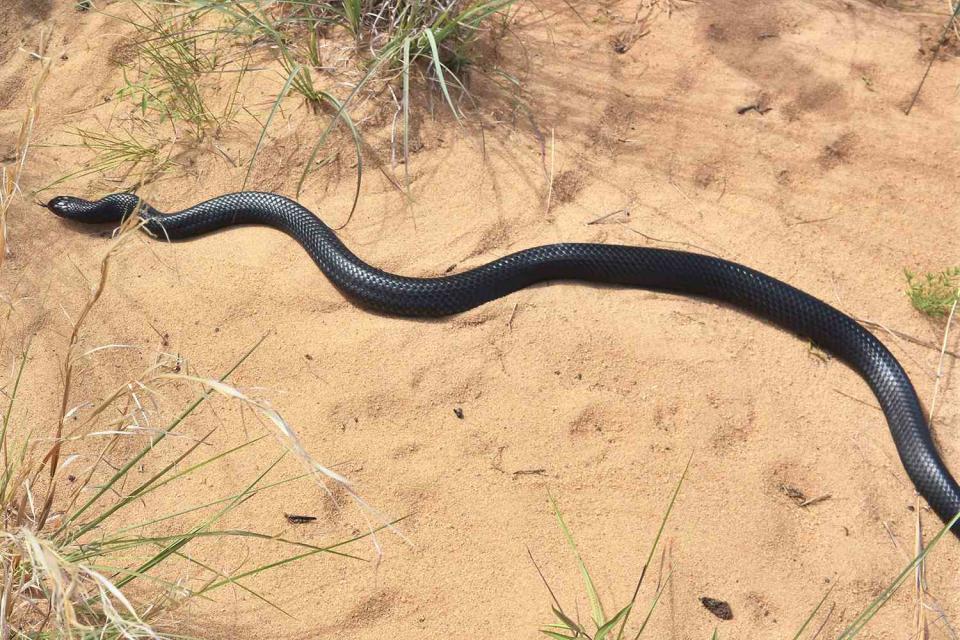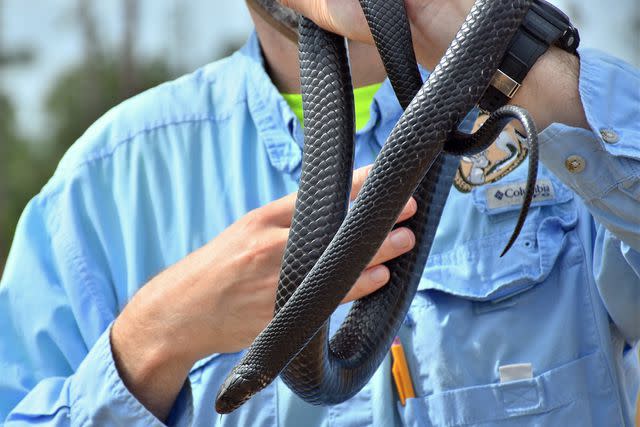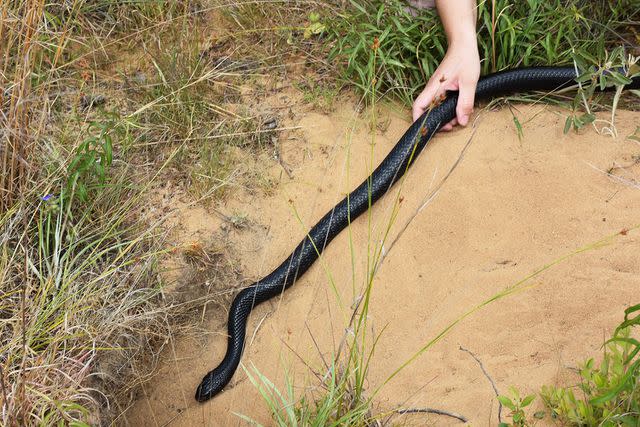41 Indigo Snakes — the Longest Snake Species Native to the U.S. — Released in Florida
The non-venomous snakes are a "lynchpin species in the longleaf pine ecosystem," which Florida experts are working to restore

Florida Fish and Wildlife Conservation Commission (FWC)
A eastern indigo snake released at The Nature Conservancy's Apalachicola Bluffs and Ravines PreserveOn April 30, The Nature Conservancy released 41 eastern indigo snakes in Apalachicola Bluffs and Ravines Preserve in Florida
The eastern indigo snake is the longest species of snake native to North America
The snake release is part of an ongoing effort to strengthen the species' population and restore Florida's longleaf pine ecosystem
Forty-one federally threatened eastern indigo snakes recently slithered off into the Florida wilderness to do good.
On April 30, The Nature Conservancy (TNC) in Florida and its partners organized the snake release at TNC's Apalachicola Bluffs and Ravines Preserve (ABRP). This marks the eighth consecutive year the organizations have released eastern indigo snakes into the area.
"Through a collaborative program to return the native, non-venomous apex predator to the region, the multi-partner effort reintroduces the federally threatened snakes to ABRP's restored sandhill habitats. The 41 snakes — 20 female and 21 male — were raised for release. A total of 167 eastern indigo snakes have now been released at the property," TNC explained in a press release.
The effort to restore Florida's eastern indigo snake population appears to be working because, in 2023, the species recovery program encountered two wild-born snake hatchlings at ABRP — offspring of previously released snakes.
Related: Rare Two-Headed Snake Undergoes Surgery in Missouri to Treat an 'Emerging Health Condition'
"Finding the two juvenile indigos on site last fall is another significant indicator that the 40-plus years of habitat restoration and management work at ABRP are recreating a functional longleaf pine-wiregrass sandhill ecosystem that benefits imperiled species like the indigos," Catherine Ricketts, the ABRP preserve manager with The Nature Conservancy in Florida, said.

Florida Fish and Wildlife Conservation Commission (FWC)
An eastern indigo snake about to be released at The Nature Conservancy's Apalachicola Bluffs and Ravines PreserveThe released eastern indigo snakes are doing their part to restore the native habitat by bringing balance to the ecosystem. Before moving to ABRP, the released snakes hatched at the Central Florida Zoo & Botanical Gardens' Orianne Center for Indigo Conservation (OCIC) and grew at the Welaka National Fish Hatchery for two years.
Related: 70 Critically Endangered Tortoises Are Thriving in the Wild 6 Months After Their Release
"As we complete our eighth annual indigo release at ABRP, joy—with a touch of pride—fills my being. It is wonderful to see these young indigos have the opportunity to fill their important role as a lynchpin species in the longleaf pine ecosystem," Dr. James E Bogan Jr., the director of the Central Florida Zoo's Orianne Center for Indigo Conservation, said.

Florida Fish and Wildlife Conservation Commission (FWC)
An eastern indigo snake enters a gopher tortoise burrow at The Nature Conservancy's Apalachicola Bluffs and Ravines PreserveOCIC monitors the previously released snakes throughout the year with foot surveys and trail cameras, and observations have shown that the reptiles are thriving.
"The future is very bright for indigo snakes at Apalachicola Bluffs and Ravines Preserve," said Brad O'Hanlon, a reptile and amphibian conservation coordinator for the Florida Fish and Wildlife Conservation Commission. "This project continues to be one of the gold-standard conservation projects in Florida, and we are grateful for the many partnerships that contribute to our mission, values, and shared goals."
Never miss a story — sign up for PEOPLE's free daily newsletter to stay up-to-date on the best of what PEOPLE has to offer, from juicy celebrity news to compelling human interest stories.
According to TNC, the eastern indigo snake, the longest snake species native to North America, is an iconic and essential component of the now rare southern longleaf pine ecosystem. The species serves a critical function to balance the wildlife community by consuming a variety of small animals."
The eastern indigo snake used to be found throughout Florida, southern Georgia, Alabama, and eastern Mississippi. However, the species' population range is far smaller today due to habitat loss and fragmentation. Before species recovery efforts began in 2017, the last time an eastern indigo snake was observed in ABRP was in 1982.
For more People news, make sure to sign up for our newsletter!
Read the original article on People.


